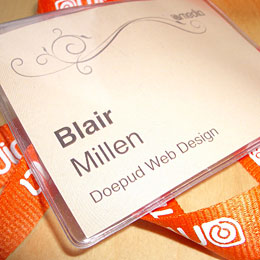
atmedia09
28th Jun 2009
Not long back from a few inspiration-soaked days in London, taking in, eleven great presentations from the likes of Robin Christopherson, Douglas Crockford and Simon Collison at the @media web design conference (no more though), the inaugural Standards.Next meetup, which focussed on HTML5 and lots of fine conversation with like-minded web geeks like Karl Dawson, Jim O'Donnell and Richard Stephenson.
Following a nice dinner at Tas and an evening chat with Karl, Jim and Dan on the Wednesday, the opening day of @media09 was soon upon us. Andy Clarke opened proceedings with a presentation that focussed on how we, as web designers and developers, should become more creative in our approach in order to safeguard our jobs. The idea that we should embrace new technologies is something that seemed to crop up during many talks and conversations that followed, in particular Molly Holzschlag's talk on HTML5 where she was joined on stage by cowboy HTML5 Bruce Lawson, who answered technical questions.
In other talks, Dan Rubin suggested adding more noise to our designs, Simon Collison offered lots of top web design and development tips based on the processes he uses at his work, Erskine Design, including the use of some magnetic, hexagonal, post-it type thingies while Jason Santa Maria reminded us all of the importance of planning ahead when designing a website by thinking smaller.
Arguably the hottest topic of the moment was dealt with by the excellent Mark Boulton, who informed and educated us on font embedding, covering important stuff like licensing and the "typographic cascade". The big message I took away was not to dismiss existing and accessible fonts like the elegant Georgia and the ubiquitous (but high-quality) Arial and Verdana.
Douglas Crockford delivered an engaging talk on "quality" and used the sprawling Winchester House with it's long history of extentions and additions as an analogy for bad programming. Chris Wilson, the main man behind Internet Explorer, was quick off the mark to renege his association with the Microsoft browser. He did suggest though that it may be about two to three years before we could be in a position to drop support for Internet Explorer 6.
Robin Christopherson ran through a few of the common issues that disabled web users face on the web today, like CAPTCHAs and accessing video content. He covered lots of interesting stuff like Easy YouTube (an accessible YouTube interface from Christian Heilmann), Zoomtext, the NVDA screen reader (free Windows software) and a cool Firefox plug-in called Webvisum. One particular free web service he demonstrated was Solona.net which seems too good to be true. It's a free service that offers real-time decryption of CAPTCHAs by a real person.. By simply sending a screen dump of the CAPTCHA an answer is sent back as text, which can then be copied and pasted into the form field. The only problem with this type of approach is that it conceeds defeat to all those who are currently using CAPTCHAs inaccessibly.
All-in-all, @media09 provided plenty of inspirational discussion covering a good range of topics.
On the Saturday, after a visit to Tate Modern where Karl and I got very excited about the display of Fluxus publications from the 60's an 70's, we went along to the Standards.Next meeting where various presentations on HTML5 were made by the likes of Dean Edwards, Remy Sharp, Steve Faulkner and Martin Kliehm. All really informative stuff (well, the bits I caught anyway). Check out HTML5doctor for an expanfding array of articles and examples on how to use HTML5.
And finally, and mostly for my own reference, here's some of the folk I met over the last few days: Graeme Porteus, Owen Gregory, Rik Hepworth, Jeroen Kuijpers, Nick Smith, Nick Fitzsimons, Andy Higgs, Natalie Downe, David Emery, George Terezakis, Richard Clark and Chris Mills.
